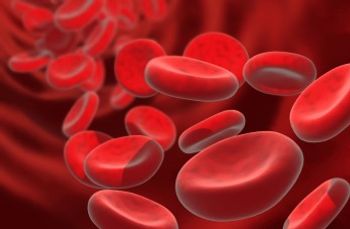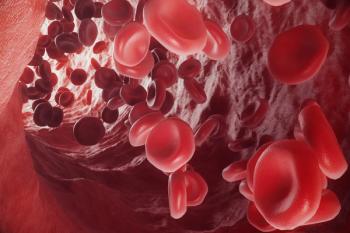
Machine Learning Approach May Predict Outcomes in RCC
A machine learning-based approach found that evaluating multiple biomarker features may identify outcomes and treatment resistance in renal cell carcinoma.
The state of the tumor microenvironment and circulating factors together may influence response in patients with advanced renal cell carcinoma (RCC) who were treated with nivolumab (Opdivo) plus cabozantinib (Cabometyx), according to David A. Braun, MD, PhD.
At the
“While most biomarker studies…have typically focused on 1 biomarker at a time, integrating both tumor and circling factors is key,” he explained.
Sole features typically evaluated include genomic alterations, tumor microenvironment, tumor-infiltrating T-cell phenotype, and circulating immune factors. “…While these provide really important biological insights, they are only modestly associated with differences in response and resistance,” Braun added. “We therefore hypothesize that integration of multiple biomarkers would improve prediction of response and resistance.”
CheckMate 9ER Trial
In the phase 3 CheckMate 9ER trial, 651 patients were randomly assigned 1:1 to receive either 240 mg intravenously every 2 weeks plus 40 mg oral cabozantinib daily or 50 mg oral sunitinib (Sutent) daily for a cycle of 4 weeks on and 2 weeks off.
Median progression-free survival (PFS) with the combination was 16.4 months (95% CI, 12.5-19.3), compared with 8.3 months (95% CI, 7.0-9.7) with sunitinib (HR, 0.58; 95% CI, 0.49-0.70). Meanwhile, overall survival (OS) was also superior at 46.5 months (95% CI, 40.6-53.8), vs 35.5 months (95% CI, 29.2-42.8), respectively, reducing the risk for death by 21% (HR, 0.79; 95% CI, 0.65-0.96).
“Using these bio specimens [from the CheckMate 9ER trial], we investigated both tumor intrinsic biomarkers and also peripheral blood biomarkers,” Braun said.
CheckMate 9ER Biomarker Analysis
Tumor biomarkers included conventional assessments like Agilent/Dako PD-L1 IHC 28-8 pharmDx assay and novel insights derived from an AI-powered analysis of Hematoxylin and Eosin (H&E) enabling single-cell resolution mapping of the tumor microenvironment, providing human-interpretable features such as cell type proportions, spatial architecture, and phenotypes.
Peripheral blood biomarker analysis included conventional immune cell composition and phenotype via flow cytometry, as well as a novel assessment of circulating extracellular matrix (ECM) proteins quantified using competitive ELISA.
High ECM levels were associated with improved PFS in the nivolumab-plus-cabozantinib arm (high vs low: HR, 0.57; 95% CI, 0.39-0.83; P = .00358) and the sunitinib monotherapy arm (high vs low: HR, 0.52; 95% CI, 0.36-0.75; P = .000438).
“These ECM biomarkers were increased in patients with kidney cancer compared to healthy volunteers,” Braun said. “In patients with higher-risk disease, whether that was IMDC poor risk disease or sarcomatoid histology, we saw that these ECM biomarkers were increased when we associated it with clinical outcomes.”
Further, the learning model discovered that higher ECM biomarker levels were associated with worse PFS among those treated with nivolumab plus cabozantinib, which included Pro-C3 (P = .0025), Pro-C6 (P = 0.0028), TUM (P = .0081), and Pro-C22 biomarkers. Similarly, Pro-C3, Pro-C6, TUM, Pro-C19, C6M, Pro-C22, and TGF-beta were biomarkers associated with worse OS with the combination regimen.
Following this standard analysis, Braun and colleagues organized their dataset integration of more than 4000 measurements across 150 patients, conducting dataset cleaning and feature engineering. They then identified the top 16 most variable features (PD-L1 staining, 4 ECM markers, 4 PBMC markers, and 7 H&E human interpretable features), accounting for 85% variability for downstream use in model building.
“We then constructed a multivariate machine learning-based model and then tested the performance of that model. I'd like to highlight that really integration of multiple factors is key,” Bruan said.
In total, 6 features appeared to be predictive of nivolumab plus cabozantinib response, according to univariate machine learning: PD-L1 level; VICM; Pro-C6; proportion of plasma cells in ESI; proportion of cancer cells in ESI; and FOXP3-positive, CD4-positive T cells.
“We can see that the predictive ability is incredibly modest,” Braun explained.
However, according to multivariate machine learning, 10 features were predictive of outcome, including PD-L1 level; VICM; proportion of plasma cells in ESI; proportion of cancer cells in ESI; LAG3-positive, CD8-positive T cells; density ratio of macrophages to fibroblasts in tumor; PD-1-positive, CD8-positive T cells; TUM; FOXP3-positive, CD
4-positive T cells; and PRO-C6.
“We see now substantially improved predictive capability,” Brain said. “…and we can see this represents all 4 buckets of our data [ECM, H&E HIF, PD-L1, and PBMC].”
Future Direction of Biomarker Analysis in RCC
“We know that kidney cancer is immunobiologically distinct from other solid tumors, so we cannot just extrapolate biomarkers from other tumors like [tumor mutation burden] or PD-L1,” Braun explained. “Despite many biomarker studies, I would say that the determinants of response and resistance to new checkpoint inhibitors and to TKIs still remains largely unknown within kidney cancer.”
The current machine-learning model that was presented at the meeting is trained on the short-term outcomes data, such as responder vs non-responder) to help elucidate mechanisms of response and resistance.
Next, Braun noted, the model will incorporate into clinical trial forecasting algorithms that use tumor growth kinetics, population-level survival information for patients treated with standards of care, and model-based response probabilities to forecast long-term survival in populations treated with a trial drug.
“Using this forecasting approach, just based on baseline values, we see a fairly good forecast using this model approach for both PFS and for overall survival,” Braun added.
He noted that the analysis did have its limitations, namely the analysis of discovery dataset only with limited features, acknowledging that the researchers need to integrate additional features into the model, such as T-cell phenotype, genetics, and molecular subtype, as well as to evaluate prognostic/predictive potential in additional clinical trials.
“…[We] found that [combining tumor and circulating biomarkers] was superior in its predictability compared to individual biomarkers alone… These findings [indicate] that the state of the tumor microenvironment and the circulating factors together influence outcome, and ultimately this provides a good foundation for future integrative biomarker discovery.”
Reference
Braun DA, Vemula SV, Cook D, et al. An integrative analysis of circulating and tumor microenvironment (TME) determinants of patient response in the Checkmate 9ER (CM 9ER) trial of nivolumab and cabozantinib (NIVO+CABO) in advanced renal cell carcinoma (aRCC). J Clin Oncol. 2025;43(16):abstract 4511. doi:10.1200/JCO.2025.43.16_suppl.4511
Newsletter
Stay up to date on recent advances in the multidisciplinary approach to cancer.


















































































